|
|
Reports and publications about research projects are partially available in German language only.
|
|
|
Investigation of two energy converters with low power demand for supply of high-temperature consumers from low-temperature district heating networks
|

heat sources & consumers

calculation
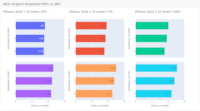
analysis
|

In a heating network 4.0 with a share of renewable energies, usual high temperature level has to be efficiently provided for certain high-temperature consumers despite lowered flow temperature. For this purpose, decentralized transfer station is adapted with an energy converter to increase flow temperature as required.
“Institut für Gebäudeenergetik, Thermotechnik und Energiespeicherung der Universität Stuttgart” (IGTE; “Institute for Building Energetics, Thermotechnology and Energy Storage – University of Stuttgart”) relies on a concept with an “absorption heat transformer” (AHT). Low-temperature heating network supplies AHT with heat, where one part of heat is raised to a higher temperature level and another part of heat is released at a lower temperature level. Electrical power is only required for pumps and controls.
“Institut für Thermodynamik Leibniz Universität Hannover” (IfT; “Institute of Thermodynamics at Leibniz University Hannover”) relies on a concept with a “compression heat pump with solution cycle” (CHPS). At component level, a CHPS is similar constructed as an ordinary “compression heat pump”, supplemented by an additional solvent pump. All heat supplied to CHPS from low-temperature heating network is raised to a higher temperature level.
FFI analyses requirements of high-temperature consumers with regard to maximum heat output, heat quantity and temperature level in order to identify areas of application of AHT and CHPS energy converters. Both energy converters are integrated into a calculation tool based on operating maps experimentally determined by IGTE and IfT. Energy expenditure, heat generation costs and CO₂ emissions of the two concepts are systematically compared by use of calculations.
This research project is supported by the German federal ministry of economic affairs and energy (project number: 22424 N).
Downloads:
- Schlussbericht, final report in German language (PDF in print quality; 9 MB)
back to index
|
|
|
UAV based thermography for automatic monitoring of local and district heating networks
|
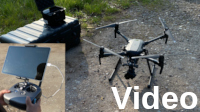
airborne thermal imaging with drone
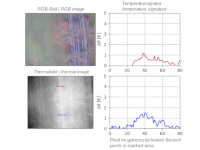
analysis
|

Operation and maintenance of district heating (DH) networks require perpetual control of DH network state. Heat losses and risk of damages caused by undetected migration of humidity into thermal insulation must be minimized for a save and efficient operation of DH networks. If buried pipes are used in DH networks a perpetual visual control of pipeline state is impossible.
Aerial thermography presents one possibility for perpetual control of DH network state. Aerial thermography means flying with a thermographic camera over a location and is currently carried out with airplanes. A drone equipped with thermographic camera, color camera that is coaxially aligned to thermographic camera and GPS receiver is tested for aerial thermography within this research project. Aerial thermography performed with this drone generates raw data sets which consist of a thermal image, a color image of the same location, position of this location and time of photograph. Goal of this research project is to generate reliable information about DH network state by combining these raw data with known DH network parameters positions of buried pipes, valves and inspection manholes (layout drawing), type of buried pipes, placing depth, texture of soil and terrain surface in the area of buried pipes and operating temperature.
Use of a drone for thermography gives some advantages against use of an airplane. Especially these advantages becomes important at control of smaller DH networks which are often operated by small or medium-sized enterprises or control of segments of larger DH networks. A drone flies in a much lower altitude than an airplane. This results in more detailed images. A drone is much smaller than an airplane. Therefore a drone can fly in areas which are inaccessible for an airplane. Administrative effort such as obtaining permit to fly is much lesser for a drone than for an airplane.
FFI collaborates with “Institut für Photogrammetrie und GeoInformation – Leibniz-Universität Hannover” (“Institute of Photogrammetry and Geoinformation – Leibniz-University Hanover”), which developes a software for analysis of data recorded with the drone described above and carry out drone flights together with FFI.
This research project is supported by the German federal ministry of economic affairs and energy (project number: 19768 N).
Publications (FFI):
- Yang, F., Grage, T., Heipke, C.: „UAV-basierte Thermographie für Fern- und Nahwärmenetze“
EuroHeat&Power, Heft 11-12/2023, p. 48–55
Downloads:
- Schlussbericht, final report in German language (PDF in print quality; 9 MB)
back to index
|
|
|
Optimization of absorption heat pumps for usage in the heat network 4.0
|
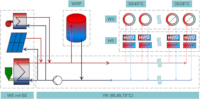
simulation model
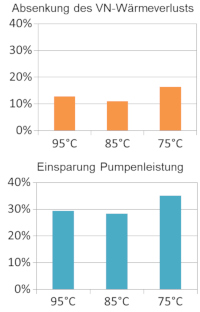
results of simulation
|

District heating (DH) networks should be mainly supplied with renewable energies plus industrial and municipal waste heat due to climate protection. These heat sources can cost-effectively be integrated into DH networks by decreasing DH flow temperature to maximal 95 °C (“heat network 4.0”). Integration of these heat sources is facilitated by decreasing DH return temperature by usage of an absorption heat pump (AHP).
Concept “house substation with integrated AHP” developed in preceding research project “Potentials of absorption heat pumps in centralized heat supply networks” has to be matched to requirements of forward-looking heat network 4.0.
FFI collaborates with “Institut für Gebäudeenergetik, Thermotechnik und Energiespeicherung der Universität Stuttgart” (“Institute for Building Energetics, Thermotechnology and Energy Storage – University of Stuttgart”). Concept “house substation with integrated AHP” is optimized both economical and technical:
- Determination of potential for reduction of operational costs by usage of an AHP in the heat network 4.0
- Development of a business model for usage of an AHP
- Adaption & enhancement of simulation model
- Testing of a new absorbent pump type of AHP
- Optimization of AHP for usage in the heat network 4.0
- Optimization of operating characteristic in partial load range of AHP
This research project is supported by the German federal Ministry for Economic Affairs and Climate Action (project number: 21315 N).
Publications (FFI):
- Yang, F., Grage, T.: „Kostenrechnung für den Einsatz von Absorptionswärmepumpen im Wärmenetz 4.0“
EuroHeat&Power, Heft 1–2/2022, p. 54–58 (German language)
Downloads:
- Schlussbericht, final report in German language (PDF in print quality; 10 MB)
back to index
|
|
|
Trenchless renewal of district heating networks
|
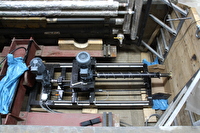
drilling device in start pit
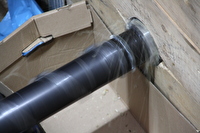
start of drilling
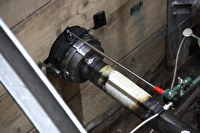
start of slit & enlargement

folded casing
|
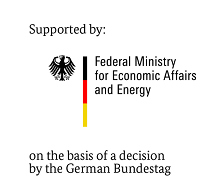
Exisiting district heating (DH) networks were designed for an operational lifetime of 30 years. Many DH networks have exceeded this designed operational lifetime. Renewal of existing DH networks requires an effort that is comparable to a new build and is associated with intrusions into surfaces. This is a big problem especially in urban areas if main roads or rail systems (tram, railway) are interrupted during these builing projects.
Target of this research project is trenchless replacement of plastic jacket compound pipes. These pipes are very common in DH networks and are used for more than 50 years. Commonly plastic jacket compound pipes are directly buried in soil. Therefore any cavity does't exist beside the plastic jacket compound pipe that shall be replaced.
The old plastic jacket compound pipe is removed with a drill process that is derived from overburden drilling process and core drilling process. Only service pipe and thermal insulation of plastic jacket compound pipe are removed. Casing is left in soil. This prevents ingress of bedding material into drilled cavity.
Casing remained in soil shall be slit and enlarged so far as a new plastic jacket compound pipe with same outer diameter like the old plastic jacket compound pipe can be pulled in. This procedure doesn't work. Either forces increase to a level that the new plastic jacket compound pipe may be damaged or casing remained in soil folds before “slit and enlarge head” into cavity.
FFI collaborates with “Institut für Bergbau, Lehrstuhl für Tagebau und Internationaler Bergbau – Technische Universität Clausthal” (“Institute of Mining, Chair of Surface Mining and International Mining” – Clausthal University of Technology), which determines required drilling process and developes a drilling device required for determined drilling process.
This research project is supported by the German federal ministry of economic affairs and energy (project number: 20378 N).
Publications (FFI):
- Kraft, S., Höhl, P.: „Grabenlose Erneuerung von Fernwärmeleitungsnetzen“
EuroHeat&Power, Heft 4–5/2022, p. 38–41 (German language)
Downloads:
- Schlussbericht, final report in German language (PDF in print quality; 44 MB)
back to index
|
|
|
Drone-based thermography as basis for asset management and maintenance strategy of district heating networks
|
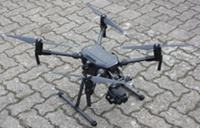
drone with cameras

color image

thermal image of same location

thermal image, layout drawing overlaid
|

Operation and maintenance of district heating (DH) networks require perpetual control of DH network state. Heat losses and risk of damages caused by undetected migration of humidity into thermal insulation must be minimized for a save and efficient operation of DH networks. If buried pipes are used in DH networks a perpetual visual control of pipeline state is impossible.
Aerial thermography presents one possibility for perpetual control of DH network state. Aerial thermography means flying with a thermographic camera over a location and is currently carried out with airplanes. A drone equipped with thermographic camera, color camera that is coaxially aligned to thermographic camera and GPS receiver is tested for aerial thermography within this research project. Aerial thermography performed with this drone generates raw data sets which consist of a thermal image, a color image of the same location, position of this location and time of photograph. Goal of this research project is to generate reliable information about DH network state by combining these raw data with known DH network parameters positions of buried pipes, valves and inspection manholes (layout drawing), type of buried pipes, placing depth, texture of soil and terrain surface in the area of buried pipes and operating temperature.
Use of a drone for thermography gives some advantages against use of an airplane. Especially these advantages becomes important at control of smaller DH networks which are often operated by small or medium-sized enterprises or control of segments of larger DH networks. A drone flies in a much lower altitude than an airplane. This results in more detailed images. A drone is much smaller than an airplane. Therefore a drone can fly in areas which are inaccessible for an airplane. Administrative effort such as obtaining permit to fly is much lesser for a drone than for an airplane.
FFI collaborates with “Institut für Photogrammetrie und GeoInformation – Leibniz-Universität Hannover” (“Institute of Photogrammetry and Geoinformation – Leibniz-University Hanover”), which developes a software for analysis of data recorded with the drone described above and carry out drone flights together with FFI.
This research project is supported by the German federal ministry of economic affairs and energy (project number: 19768 N).
Publications (FFI):
- Herbst, V., Grage, T.: „Drohnegestützte Thermografie als Inspektionsverfahren für Nah- und Fernwärmenetze“
EuroHeat&Power, 49. Jg (2020), Heft 9, p. 34–39 (German language)
- Herbst, V., Grage, T.: „Drohnen überwachen Leitungen per Infrarot“
Technik und Leben, Ausgabe 2/2020, p. 1+2 (German language)
- Fernwärme-Forschungsinstitut: „Zustandserfassung von Fern- und Nahwärmenetzen durch drohnengestützte Thermografie“
3R Fachzeitschrift für sichere und effiziente Rohrleitungssysteme, 01-02|2019, p. 115–117 (German language)
Downloads:
- Schlussbericht, final report in German language (PDF in print quality; 55 MB)
back to index
|
|
|
Potentials of absorption heat pumps in centralized heat supply networks
|

simulation model
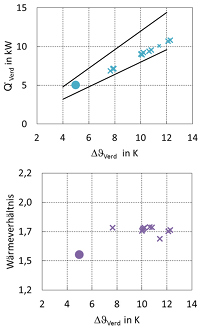
measured data
|

District heating (DH) is a cross-sectoral key technology for transformation of existing energy supply and energy transition concepts. Lowering of network temperature is a prerequisite for high energy efficiency and economic operation of the fourth district heating generation. An innovative heat supply concept is developed as part of this research project.
The technological solution is integration of a thermally driven absorption heat pump (AHP) in house substation. Energy from DH forward pipe and return pipe is used to drive AHP using this innovative heat supply concept, whereby heat supply of heat consumer direct from DH network is ensured. Operating parameters of AHP are adapted to operation of DH network. Interactions of lowered return temperature on entire DH network, e.g. distribution losses, DH network pump performance and service life of DH network components are determined both experimentally and by simulation.
FFI examines this innovative heat supply concept by simulation calculations. Sub-models heat generator, distribution network with network pumps, house substation with integrated AHP and heat consumer are gradually developed with analytical and static modeling approaches to reflect individual operating characteristics of DH network segments. Finally sub-models are merged to an overall model in order to quantify energy balance as well as integral influences of modified house substation on entire DH operation.
FFI collaborates with “Institut für Gebäudeenergetik, Thermotechnik und Energiespeicherung der Universität Stuttgart” (“Institute for Building Energetics, Thermotechnology and Energy Storage – University of Stuttgart”), which performs laboratory tests for implementation and testing of this innovative heat supply concept. At first time an AHP is designed and constructed whilst taking into account typical operating parameters of DH networks. At various network-side and consumer-side temperatures, Performance ratios of AHP are measured at various DH network-side and heat consumer-side temperatures. A characteristic diagram for steady-state operation is generated from these measurements. Both full and partial load operations are examined based on DH network data in following demonstration mode. Then measured results are incorporated into simulation model of FFI in order to further optimization and calibration of simulation model. Finally simulation calculations are run to quantify following effects of integrated AHP on an entire DH system:
- Lowering DH return temperature
- Improving efficiency of heat supply
- Reduction of heat losses of DH networks
- Saving power of network pumps
- Increase of technical service life of DH network components
This research project is supported by the German federal ministry of economic affairs and energy (project number: 19696 N).
Publications (FFI):
- Yang, F., Grage, T.: „Senkung der Rücklauftemperatur im Fernwärmenetz“
EuroHeat&Power, 48. Jg (2019), Heft 3–4, p. 34-37 (German language)
Downloads:
back to index
|
|
|
Development of empirical methods for determination of thermal conductivity and heat loss based on metrological methods for pre-insulated plastic bonded twin pipe systems
|
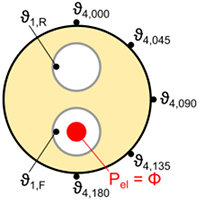
radial sensor application
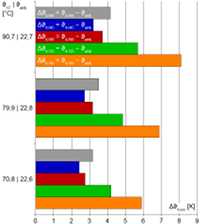
measured values
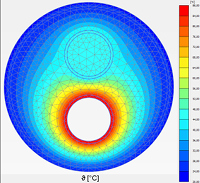
simulation (FEM)
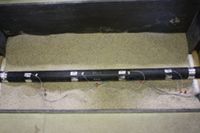
test set-up in soil
|

Usage of pre-insulated twin pipes in district heating (DH) networks gives some advantages against single pipes. Trenches can be sized narrower. This reduces civil engineering costs and gives new DH development potentials in areas with limited space e. g. historic town centres. Branches of service pipe and return pipe take place at the same levels. Wall ducts for building feed are reduced from two to one. Heat loss of a twin pipe is lower than heat loss of two single pipes according to manufacturer's data for single and twin pipes with equal service pipe dimensions and equal thermal insulation series. Some energy utility companies have measured heat losses in their twin pipe DH networks that significantly differs from heat loss according to manufacturer's data. Because heat loss is a crucial criterion for DH network dimensioning, partially significant differences between measured heat losses and manufacturer's data hinder usage of pre-insulated twin pipes in DH networks.
Any unified calculation method doesn't exist for heat loss of twin pipes. One reason for this is, that the more complex geometry of twin pipes compared to single pipes disallows any analytic solution. This applies mutatis mutandis for determination of thermal conductivity of thermal insulation in twin pipes. Also dimensioning of pipe statics is impossible without knowledge of thermal properties in twin pipes. Also this hinder usage of pre-insulated twin pipes in DH networks.
One goal of this research project is development of easy to use calculation methods for heat loss and determination of thermal conductivity of thermal insulation in twin pipes. Hindrances for usage of twin pipes in DH networks shall be removed with the capability of an easy to use and sufficiently accurate calculation method for heat loss.
Simulations with finite element method (FEM) are done on the one hand and measurements in laboratory with repeatable enviroments (air, soil) are done on the other hand to develop calculation methods. Development of calculation methods is finished now. This goal of the research project is achieved. A first implementation of this research result are measurements for determination of thermal conductivity of thermal insulation in twin pipes by customer's order. Furthermore this research result shall be included into standards EN 15698-1, EN 15632 and EN 13941. A first FEM simulation of pipe statics is done based on now known thermal properties in twin pipes.
FFI collaborates with “Institut für Geotechnik – Leibniz-Universität Hannover” (“Institute for Geotechnical Engineering – Leibniz-University Hanover”), which performs the FEM simulations. Additionally some companies of DH sector support this research project with provided twin pipes and services.
This research project is supported by the German federal ministry of economic affairs and energy (project number: 1 EWN).
Publications (FFI):
- Kraft, S., Narten, M.: „Berechnungsverfahren für Doppelrohre“
EuroHeat&Power, 49. Jg (2020), Heft 3, p. 62-64 (German language)
- Kraft, S.: “Determination of thermal conductivity of pre-insulated twin pipes”
EuroHeat&Power, English Edition, I/2019, p. 26-30 (English language)
- Kraft, S.: „Bestimmung der Wärmeleitfähigkeit von werkmäßig gedämmten Doppelrohren“
3R Fachzeitschrift für sichere und effiziente Rohrleitungssysteme, 09|2018, p. 82-86 (German language)
- Schuchardt, G.-K., Kraft, S.: „Bestimmung der Wärmeverluste werkmäßig gedämmter Verbundmanteldoppelrohre“
EuroHeat&Power, 46. Jg (2017), Heft 12, p. 15-18 (German language)
Downloads:
back to index
|
|
|
Operational lifetime of district heating systems
|
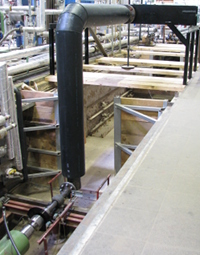
90°-bow, set-up for load test

linear water tightness, bending of a flexible pipe before test
|

The whole district heating (DH) supply system (generation — distribution — consumer) is
in an unstable condition once the technical lifetime of the system has passed. The
frequency of defects within the system increases jeopardizing the reliability of supply.
Therefore, operators of DH systems are bound to know the condition of the DH supply
network and its components within as detailed as possible for taking relevant steps
to avoid serious damages. For this purpose, investments for the maintenance of the
system have to be planned, budgeted and done. These investments are of major importance
for the economic operation of DH systems. Therefore, the timing of these measures
has to suit to the condition of the DH system in order to allow
- Market-oriented and more flexible operation of combined heat and power (CHP)-plants and heat sources,
- Attachments of thermal storages for a more flexible operation of
CHP-plants and heat sources attached,
- flexible operation of CHP and heat sources, e.g. by attaching
thermal storages,
- Utilizing the thermal inertia of the heat distribution system,
- Integration of most different and renewable heat
(solar-, geo-thermal, waste heat, etc.),
- Densifying the DH grid by attaching additional customers.
back to index
|
|
|
Possibilities and limitations of trenchless district heating supply systems
|
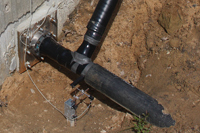
field test: trenchless laid DH pipe, measuring points nearby fixed point
|

Under the coordination of the AGFW (German Heat and Power Associating), the FFI evaluated
the "Possibilities and Limitations of trenchless district heating supply systems".
On cooperation with five scientific and three industrial partners, field tests on 10 different
trenchless DH-piping systems have been executed, simulating heat loads of DH systems in situ.
Within this context, the FFI supervised the operation and data collection of these most
sophisticated field tests and focused on the evaluation of the DH piping systems previous
to and after operation. Summarizing, this projects is outstanding concerning the expense,
effort and extent of field tests performed. Thus, the uniqueness of this project necessarily
leads to additional and most urgent issues carrying the contents of this project into the future
of DH research. The project was supported by the federal ministry of economy and energy (FKZ 03ET1063A).
back to index
|
|
|
Bedding resistance of district heat pipes under cyclic load
|

cyclic load test
|

Within this research project, some basic knowledge gaps regarding the bedding
resistance of district heat pipes due to lateral alternating loads were filled.
In cooperation with the Institute for Geotechnical Sciences Hannover (IGtH),
the FFI ran systematical test series on a pilot DH piping site in a 1:1 scale
for different alternating transversal loads. Project partners in this research
association were the geotechnics institute at the Hanover Leibniz University
(IGtH) and the district heat - research institute (FFI). The FFI task was to
run systematical experiments as pilot-plant testing of 1:1 scale district
heating pipe segments under different alternating loads transverse to the axis
of line. Applying appropriate instrumentation, the bedding resistance is related
to the load intensity and number of cycles. Furthermore, the FFI scheduled
laboratory tests for examining material properties of the insulation and plastic
sheath pipes under cyclic loads. These experiments are an important element
within the context of understanding the load-bearing behavior DH piping systems.
This project was supported by the federal ministry of economy and energy (FKZ 03ET1063C).
back to index
|































